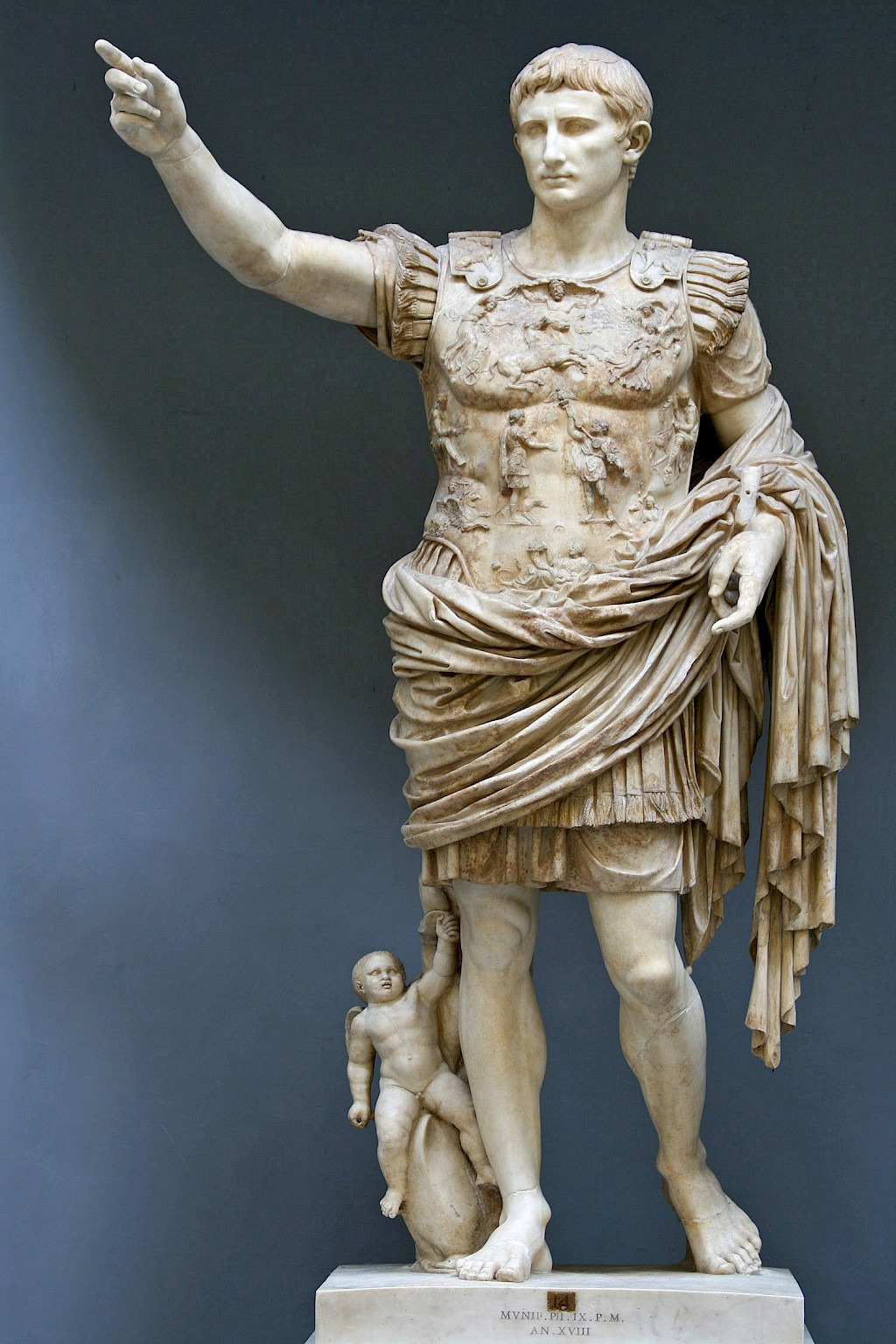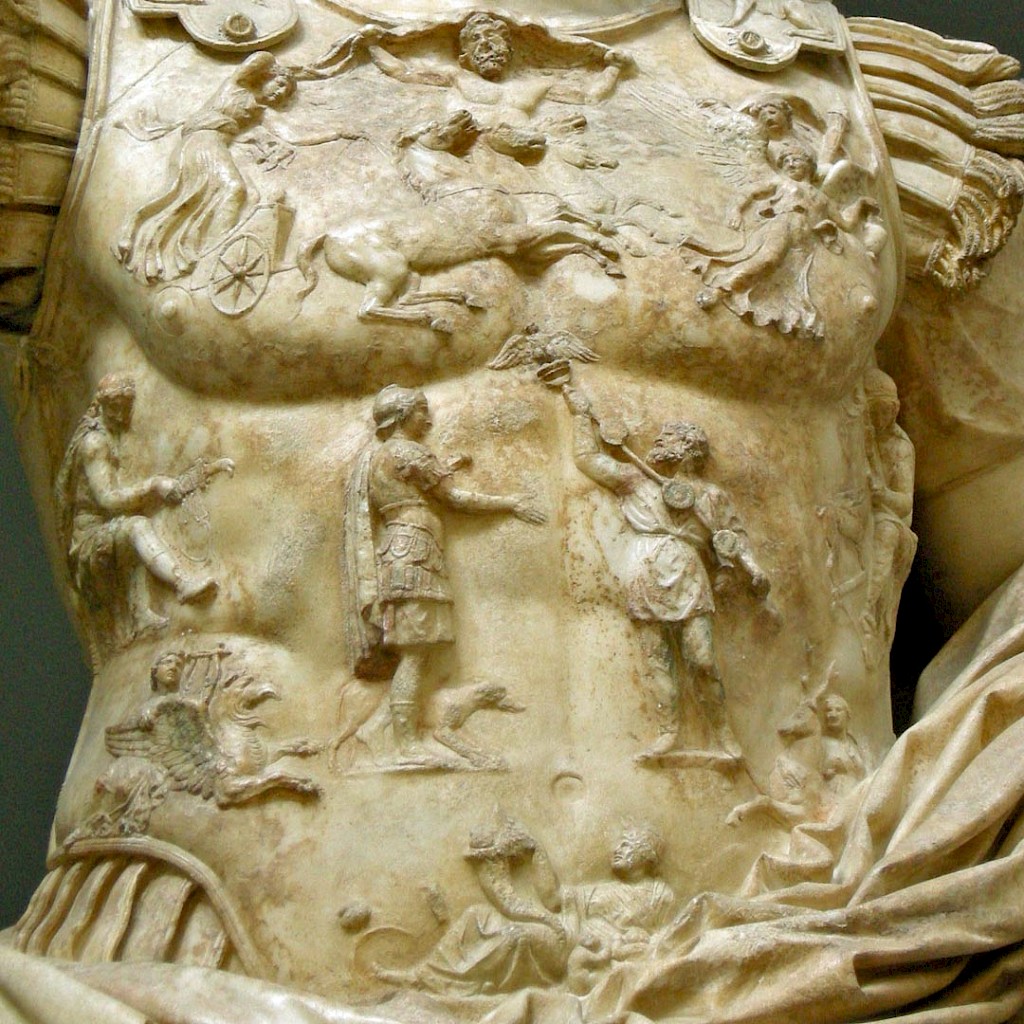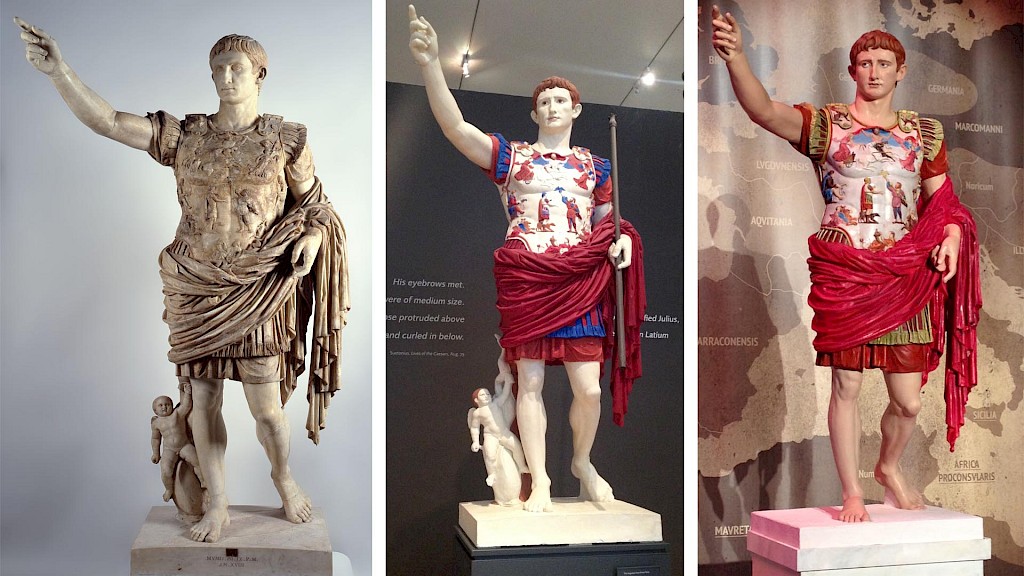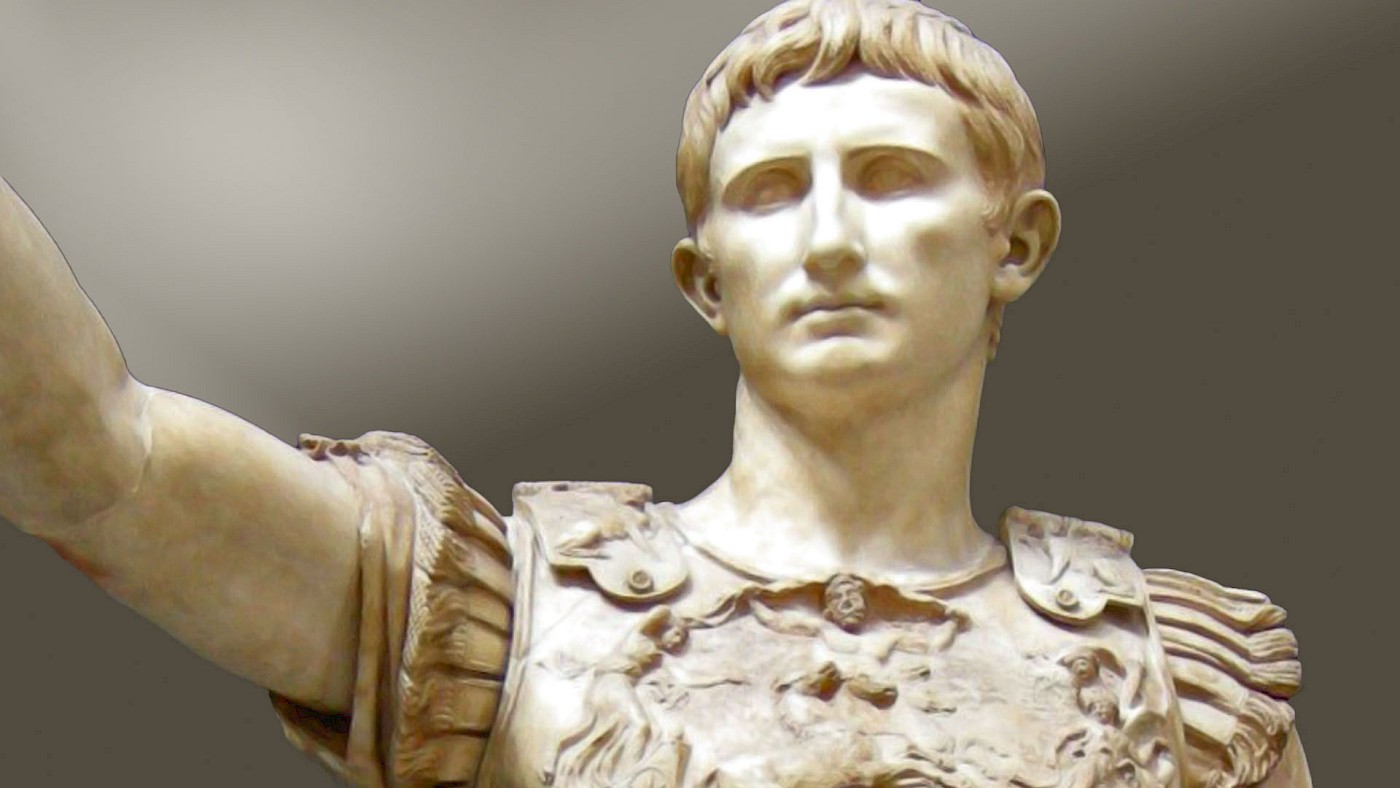One of the more interesting monuments made during the reign of Rome’s first emperor Augustus (r. 27 BC–AD 14) is a statue referred to as the “Augustus of Prima Porta”.
I still remember the talk that one of my teachers in Mediterranean archaeology gave about this statue. It hammered home, to me, the idea that objects are not simply neutral, but are in fact imbued with meaning. Later, I read lots of stuff on archaeological theory that helped me look even better at ancient objects. One of the writers I really got into was Ian Hodder, a prominent archaeologist, who argues that material culture is “meaningfully constituted”, i.e. material culture, including statues, are “actively employed as part of social strategies” (as per his own website).
And this statue of Augustus is definitely a good example of a piece of material culture that was used as part of a social strategy. Examining the statue itself, its various figurative elements, and indeed the location where it was found give us a glimpse into the many possible uses and meanings of ancient Roman art.
The emperor Augustus
Augustus was born Gaius Octavius (“Octavian”) in 63 BC. His maternal great-uncle was known other than the famous general Julius Caesar. Caesar himself, of course, was a central figure in the troubles that the Roman Republic experienced in the second half of the first century BC. He emerged victorious after a bloody civil war, and was appointed dictator.
Now, a dictator was actually an official position within the Roman Republic. In times of crisis, a dictator would be appointed to bring order to chaos. The position was always intended to be temporary, but Caesar showed little sign of ever wanting to relinquish his powers. When he was appointed dictator for life, the time was ripe for his political opponents, who feared a return to the days of kingship, to cut him down: Caesar was famously stabbed to death on the Ides of March (i.e. the fifteenth of that month) in 44 BC, plunging the Republic once again into disorder.
In Caesar’s will, Gaius Octavius had been named as his adopted son and heir. Together with Mark Antony, who had been a good and loyal friend of Caesar’s, and Marcus Lepidus, another close ally, he formed a triumvirate and vowed to defeat Caesar’s assassins. They remained united until they quashed their opponents at the Battle of Philippi (Greece) in 42 BC, after which the three ambitious men turned on each other. Lepidus was forced into exile. Mark Antony went to Egypt, where he famously cavorted with Queen Cleopatra, and was ultimately driven to suicide after their defeat at the hands of Octavian at the Sea-Battle of Actium in 31 BC.
Octavian was now free to rule the Roman Republic as its sole leader. But he was careful not to make the same mistakes as his maternal great-uncle. He presented himself as the protector of the Roman Republic. In 27 BC, the Senate awarded him the name Augustus (“Exalted One”). They also referred to him as the Princeps (“First Head”, i.e. leader or most senior figure). Making sure that he would not be perceived as a monarch, he was presented as merely the primus inter pares, i.e. the “first among equals”.
In reality, of course, Augustus ensured that the power of the Republic rested firmly in his hands. While he would never have been designated as such in his own time, Augustus was nonetheless the first of a long line of monarchs that we refer to as emperors. He was fortunate to reign for a long period of time, from 27 BC to AD 14, as he had to chance to pass important reforms and to establish a dynasty of his own.
The Augustus of Prima Porta
The statue was found in the villa of Augustus’ wife Livia at Prima Porta, a few kilometres north of Rome. It depicts Augustus in an unusual way: equipped as a general, with bare feet, and one hand outstretched in a pose familiar from portraits of orators.

The marble statue was made shortly after Augustus’ death. Some believe it may have been a copy of a bronze statue that celebrated his victory over the Parthians in 20 BC. My erstwhile teacher of Mediterranean archaeology disagreed with that assertion, since Augustus had been very careful not to have himself depicted as a military leader – at least not in public. There were a number of reasons for that.
First of all, Augustus carefully presented an image of himself as restraint and sober, as well as pious. Indeed, his name – Augustus – has a distinctly religious ring to it, and many portraits intended for public consumption tended to present him as a civilian or dressed like a priest (since he also officiated). Secondly, Augustus had “saved” the Republic from decades of internal strife and had ushered in a new era of peace, the Pax Romana, and it’s likely that he would not have wished to emphasize his military achievements.
There is also another reason: Augustus was a shrewd politican, but a poor general. Fortunately, he could rely on men who were better warriors than he was. As a result, it would not have made a lot of sense to depict himself as a conquering general, since that would undercut his military allies, on whose loyalty he depended to secure his rule.
The scene on the cuirass
And speaking about military accomplishments, the scene on the cuirass deserves to be examined in closer detail. In the centre, a figure in baggy trousers is giving a standard to a Roman soldier. Individuals in trousers are invariably barbarians (i.e. non-Greek and non-Roman):

The trousered individual is meant to be a Parthian. The scene commemorates a moment that had been a great political win for Augustus: the return of the Roman standards that the Parthians had taken after their defeat of Crassus at the Battle of Carrhae in 53 BC. To be sure, this was a political win, not a militarily one, since the return of the standards had been brokered along diplomatic channels.
The Roman soldier has been interpreted as representing Tiberius, who was present when the Parthians returned the standards. Tiberius was a son of Livia’s from an earlier marriage. Augustus had no living heirs of his own and had, at long last, grudgingly accepted Tiberius as his son and successor. If this interpretation is correct, it would further argue in favour of the statue being made after Augustus’ death, and displayed at Livia’s villa.
The figures that frame this scene are all divinities: we see e.g. the sky god at the top and Mother Earth near the bottom. Symbolically, the gods represent divine sanction of Augustus’ peace. Furthermore, the horn of plenty, held in Mother Earth’s hands, symbolizes the wealth that Augustus’ peace has brought to the Roman Empire.
After this article was originally published, user @e-pe-me-ri pointed out on Twitter that this article suggests the soldier represents Roma, the personification of the city of Rome. The soldier does appear to have feminine features, and the type of helmet is often associated with Roma. There are also doubts about whether or not the trousered figure is really a Parthian. Nevertheless, the main message of the cuirass (victory, prosperity, divine sanction) remains intact.
A descendant from Venus
One of the key things that Augustus did to ensure his reign would be successful was to use art and architecture as propaganda. To celebrate his defeat of Caesar’s assassins, he contructed a temple to Mars Ultor (i.e. “Mars the Avenger”), which featured statues of Mars (the god of war), his paramour Venus (goddess of love), as well as a statue of the recently deified Julius Caesar himself.
The reason for this was obvious to any Roman: the clan of the Julii traced back their ancestry to Ascanius, the son of Aeneas, the Trojan who had fled Troy after it had been destroyed by the Greeks and who eventually settled his people in Latium, where ultimately the city of Rome would be founded. Ascanius was given a second name, Julus, from which the clan derived its name. Since Aeneas himself had been the son of Venus, this meant that the Julii themselves could claim divine descent from that goddess.
In Roman times, an adopted child had the exact same rights and status as biological offspring. Augustus could thus lay claim to the same divine ancestry as Julius Caesar himself. Venus was associated with dolphins (once myth after all suggests she was born in the sea), and her offspring included, according to some, the divinity Eros, who was known to the Romans as Cupid and by this time often depicted as a chubby little child.
Hence the presence of a Cupid riding a dolphin near this statue’s right leg. It may also explain why Augustus’ feet are bare: heroes as well as gods were routinely depicted as wandering the world without any kind of shoes to protect their feet. As such, this element may have further served to emphasize the ruler’s divine ancestry. The fact that the statue is literally larger-than-lifesize would also have made an impact.
And this, too, would have been another important reason that the statue was not intended for general consumption: in public, Augustus was adamant that he not be treated as a god. But in private, of course, plans were already in motion for him to be elevated to godhood after death, just as Julius Caesar had been proclaimed a divinity.
Closing thoughts
The Augustus of Prima Porta gives a good idea of how ancient statuary was imbued with meaning. Unlike most portraits of Rome’s first emperor, this statue depicts the emperor as a hero or a god, a military leader as well as a great politician (orator). The scene on the breastplate emphasizes a major victory over an old enemy, the Parthians, and the prosperity that his Pax Romana brought the world.
It is, in fact, a boastful portrait of a man who had, in his life, been careful to show nothing but the utmost restraint and humility. He didn’t make the same mistakes that led to the death of his maternal great-uncle Julius Caesar, nor was he as brazenly ambitious as the men who had fuelled the civil wars. This statue, probably made after his death, would have been intended to be seen only in private, by people who understood the new reality of the Roman Empire and the importance of restraint.
And, to tie in to an earlier article that I wrote, the statue would originally have been brightly painted. A few different reconstructions have been proposed, two of which are shown below, with the statue as it is today depicted at the far left. The reconstruction at the far right is probably more accurate (despite the absence of the dolphin and Cupid):

After his death in AD 14, Augustus was succeeded by Tiberius, who ensured that Augustus would, like Caesar before him, be proclaimed a god, establishing a tradition. In many ways, Tiberius was the opposite of Augustus: an experienced general but a poor statesman, who eventually withdrew from public life and came to care little about what people thought about him.
